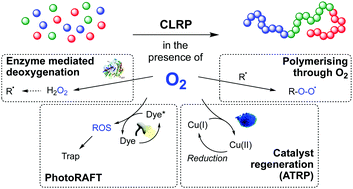当前位置:
X-MOL 学术
›
Chem. Soc. Rev.
›
论文详情
Our official English website, www.x-mol.net, welcomes your feedback! (Note: you will need to create a separate account there.)
Up in the air: oxygen tolerance in controlled/living radical polymerisation
Chemical Society Reviews ( IF 46.2 ) Pub Date : 2018-05-02 00:00:00 , DOI: 10.1039/c7cs00587c Jonathan Yeow 1 , Robert Chapman , Adam J Gormley , Cyrille Boyer
Chemical Society Reviews ( IF 46.2 ) Pub Date : 2018-05-02 00:00:00 , DOI: 10.1039/c7cs00587c Jonathan Yeow 1 , Robert Chapman , Adam J Gormley , Cyrille Boyer
Affiliation

|
The requirement for deoxygenation in controlled/living radical polymerisation (CLRP) places significant limitations on its widespread implementation by necessitating the use of large reaction volumes, sealed reaction vessels as well as requiring access to specialised equipment such as a glove box and/or inert gas source. As a result, in recent years there has been intense interest in developing strategies for overcoming the effects of oxygen inhibition in CLRP and therefore remove the necessity for deoxygenation. In this review, we highlight several strategies for achieving oxygen tolerant CLRP including: “polymerising through” oxygen, enzyme mediated deoxygenation and the continuous regeneration of a redox-active catalyst. In order to provide further clarity to the field, we also establish some basic parameters for evaluating the degree of “oxygen tolerance” that can be achieved using a given oxygen scrubbing strategy. Finally, we propose some applications that could most benefit from the implementation of oxygen tolerant CLRP and provide a perspective on the future direction of this field.
中文翻译:

悬而未决:受控/活性自由基聚合中的氧耐受性
受控/活性自由基聚合 (CLRP) 中的脱氧要求对其广泛实施造成了重大限制,因为必须使用大反应体积、密封反应容器以及需要使用专用设备,如手套箱和/或惰性气体来源。因此,近年来人们对开发克服 CLRP 中氧抑制作用的策略产生了浓厚的兴趣,从而消除了脱氧的必要性。在这篇综述中,我们重点介绍了实现耐氧 CLRP 的几种策略,包括:“通过”氧气“聚合”、酶介导的脱氧和氧化还原活性催化剂的连续再生。为了进一步澄清该领域,我们还建立了一些基本参数来评估使用给定的氧气洗涤策略可以实现的“氧气耐受性”程度。最后,我们提出了一些最能从耐氧 CLRP 的实施中获益的应用,并提供了对该领域未来发展方向的展望。
更新日期:2018-05-02
中文翻译:

悬而未决:受控/活性自由基聚合中的氧耐受性
受控/活性自由基聚合 (CLRP) 中的脱氧要求对其广泛实施造成了重大限制,因为必须使用大反应体积、密封反应容器以及需要使用专用设备,如手套箱和/或惰性气体来源。因此,近年来人们对开发克服 CLRP 中氧抑制作用的策略产生了浓厚的兴趣,从而消除了脱氧的必要性。在这篇综述中,我们重点介绍了实现耐氧 CLRP 的几种策略,包括:“通过”氧气“聚合”、酶介导的脱氧和氧化还原活性催化剂的连续再生。为了进一步澄清该领域,我们还建立了一些基本参数来评估使用给定的氧气洗涤策略可以实现的“氧气耐受性”程度。最后,我们提出了一些最能从耐氧 CLRP 的实施中获益的应用,并提供了对该领域未来发展方向的展望。


























 京公网安备 11010802027423号
京公网安备 11010802027423号